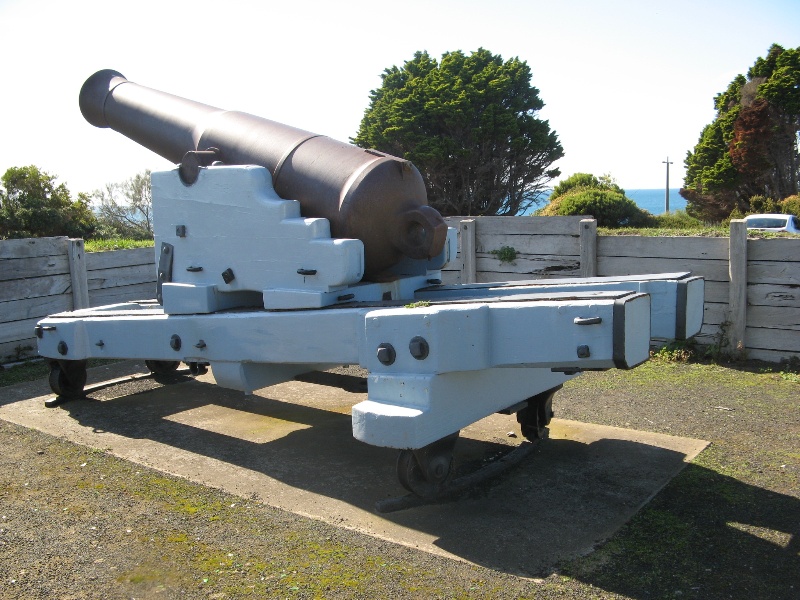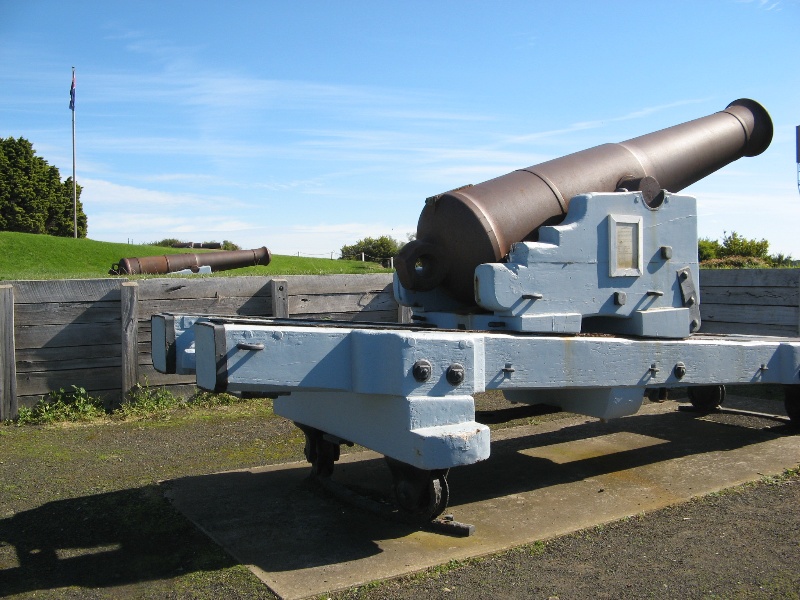GUN (68 POUNDER)
VICTORIA PARADE PORTLAND, GLENELG SHIRE
-
Add to tour
You must log in to do that.
-
Share
-
Shortlist place
You must log in to do that.
- Download report



Statement of Significance
What is significant?
This 68-pounder gun currently (in 2011) located at Battery Hill was cast at the Low Moor foundry in England in 1861. It was one of the guns purchased in response to the 1863 report by British military advisers on the defence of Port Phillip, which recommended that nineteen guns of this type be bought for the defence of Hobsons Bay (in the northern part of Port Phillip). It is not known exactly when the gun was brought to Portland but it probably arrived in the late 1860s or the 1870s and was used for training purposes by volunteers and part-time militia at the Drill Hall (VHR H2245). It was moved to the park in front of the old court house in 1919 and to Battery Hill in 1922, and following restoration it was placed in its current position in 1984. The wooden gun carriage and traversing slide were constructed by the Royal Carriage Department which was attached to the Royal Gun Factory at Woolwich, most likely at the same time as the gun.
This 68 pounder gun, with the a manufacture number 10339, is a smooth-bore cannon mounted on a wooden carriage and traversing slide which runs on two short sections of traverse rail. The gun is marked 'Low Moor' over '10339' over '1861' on the left hand trunnion (the cylindrical projection from the side of the barrel that rests on the carriage and forms a pivot point), and '7049', an arrow, '95 - 2 - 6' and '1861' on the barrel.
How is it significant?
The 68 pounder gun is of historical and scientific (technical) significance to the state of Victoria.
Why is it significant?
The 68 pounder gun is of historical significance for its association with the early defence of the colony of Victoria and as a reminder of the importance of coastal defences in the early colonial period. It demonstrates the dependence of the young colony on British military expertise and on the British manufacture of artillery. The relatively short life of the gun as part of the defences of Port Phillip reflects the rapid changes of gun technology during this period, and in particular the introduction of rifled guns of much greater accuracy and range than the old smooth bore cannon, and the subsequent transfer of obsolete weapons to strategically less important sites.
The 68 pounder gun is of scientific (technological) significance as a now extremely rare example of nineteenth century naval artillery, which was designed to be accurate over very long distances. The wooden gun carriage is also a rare surviving example of its kind.
-
-
GUN (68 POUNDER) - History
CONTEXTUAL HISTORY
[A Conservation Management Plan of Victorian Guns and Cannon, South Western Victoria was commissioned from Archaeo Cultural Heritage Services in 2007. The following information is taken from that report.]
Great Britain was the undisputed lord of the seas during the nineteenth century and part of its system of defence was to protect the lines of communication to its bases throughout the Empire. This was done by creating small bastions capable of defending harbours against foreign attack only until British forces could arrive. These limited defences often left locals fearful of their safety.
There were fears in Victoria in the early nineteenth century about a possible French invasion, and the discovery of gold in Victoria in 1851 and the outbreak of the Crimean War three years later made local fearful of a possible Russian invasion.
Colonials were dependent for defence on Britain's expertise, construction knowledge and arms technology, and on protection by the Royal Navy. They relied on military arms provided by the British, which were often obsolete pieces of artillery, and on British design of and approval for defensive constructions. Many of Victoria's forts and batteries were equipped with guns which had been formerly used on British forts or ships.
In 1877 Britain sent two military advisers and members of the Royal Engineers, Sir Major-General William Jervois and Lieutenant Colonel Peter Scratchley, to Australia to develop a scheme of defence for each of the colonies. For Victoria they recommended the development of defences for the principal ports: Geelong and Melbourne in Port Philip Bay, Portland, Warrnambool and Port Fairy in western Victoria and Lakes Entrance in Gippsland. The resources of western Victoria were proposed to be protected by a co-ordinated system which involved installing fixed defences at the strategically important and valuable ports of Portland, Warrnambool and Port Fairy, where batteries located at fixed elevated positions could bombard attacking ships with marine artillery.
The guns
Most coastal defence artillery pieces are naval artillery either taken from a ship or supplied directly to a battery. Naval artillery is generally larger and more powerful than the lighter land-based artillery and is designed specifically to destroy ships.
Nineteenth century artillery was cast using a unique mould for each cannon. In Great Britain cannons were made in Scotland and northern England by Low Moor, Walker and Carron amongst others, and taken to Woolwich for testing. Later in the nineteenth century new techniques developed, such as rifling the barrel for accuracy and breach (rather than muzzle) loading for greater rates of fire. Many of these new sorts of artillery were made at the Royal Gun Factory at Woolwich.
Nineteenth century naval artillery was heavy and difficult to manoeuvre into firing position. They were therefore secured onto wheeled wooden trolleys. Attachments on the carriages allowed for bock and tackle pulley systems to be used in servicing and firing the guns. As artillery became heavier, these means of moving the guns were no longer adequate, and traversing slides with their own wheels were developed that allowed the gun carriage to be mounted on the slide. These absorbed the recoil of the guns when fired and returned the gun to its original position.
After their useful life in England, many cannons were melted down and the metal reused, but some were given to colonial authorities, and would replace even older artillery in the larger ports, and the even older artillery in these ports might be given to lesser ports or even scrapped.
There is in Portland, Warrnambool and Port Fairy in western Victoria a collection of fourteen guns manufactured in Britain in the nineteenth century which are now extremely rare examples of their kind.
HISTORY OF OBJECT
The 68-pounder smooth-bore cannon (currently located in a modern timber gun bay on the eastern side of the Portland Battery) was cast at the Low Moor foundry in England in 1861. It is probably one of the guns purchased in response to the 1863 report by Captain Scratchley on the defence of Port Philip, which recommended that 19 guns of this type be bought for the defence of Hobsons Bay (in the northern part of Port Philip).
As was the case for the earlier 32-pounder guns used for the defence of Melbourne in 1850, which were moved to Western Victoria when newer and more sophisticated artillery became available, the 68-pounder guns now at Portland were transferred to western Victoria in the 1860s and 1870s. The relatively short life of these guns as part of the frontline defences of Port Philip reflects the rapid changes of gun technology during this period, and in particular the introduction of rifled guns of much greater accuracy and range than the old smooth bore cannon.
It is not known exactly when the gun was brought to Portland but it possibly arrived in the late 1860s or the 1870s and was used for training purposes by volunteers and part-time militia, probably at the Drill Hall, moved to the Memorial Triangle (in front of the old court house) in 1919 and thence to Battery Hill in 1922. Following restoration it was placed in its current position in 1984.
The wooden gun carriage and traversing slide were constructed by the Royal Carriage Department which was attached to the Royal Gun Factory at Woolwich. The timber is generally regarded to be Burmese teak. This is unusual as oak was preferred timber,, though teak was also used. It is not known whether the carriage and slide were constructed at the same time as the guns but this is likely.
GUN (68 POUNDER) - Assessment Against Criteria
a. Importance to the course, or pattern, of Victoria's cultural history
The 68-pounder gun is of historical significance for its association with the early defence of the colony of Victoria and as a reminder of the importance of coastal defences in the early colonial period. It demonstrates the dependence of the young colony on British military expertise and on the British manufacture of artillery. The relatively short life of the gun as part of the frontline defences of Port Phillip reflects the rapid changes of gun technology during this period, and in particular the introduction of rifled guns of much greater accuracy and range than the old smooth bore cannon and the subsequent transfer of obsolete weapons to strategically less important sites.
b. Possession of uncommon, rare or endangered aspects of Victoria's cultural history.
The 68-pounder gun is a now extremely rare example of nineteenth century naval artillery. Nineteenth century wooden gun carriages are also extremely rare, and the survival of its original carriage increases the significance of the gun.
c. Potential to yield information that will contribute to an understanding of Victoria's cultural history.
d. Importance in demonstrating the principal characteristics of a class of cultural places or environments.
e. Importance in exhibiting particular aesthetic characteristics.
f. Importance in demonstrating a high degree of creative or technical achievement at a particular period.
The 68 pounder gun is a most unusual surviving example of nineteenth century naval artillery and is a rare demonstration of nineteenth century British military technology, which was designed to be accurate over long distances.
g. Strong or special association with a particular community or cultural group for social, cultural or spiritual reasons. This includes the significance of a place to Indigenous peoples as part of their continuing and developing cultural traditions.
h. Special association with the life or works of a person, or group of persons, of importance in Victoria's history.
GUN (68 POUNDER) - Plaque Citation
This rare example of 19th century British naval artillery was cast in England in 1861 and purchased for the defence of Port Phillip. It was used for training at the Portland drill hall from the 1870s and moved here in 1922.
GUN (68 POUNDER) - Permit Exemptions
General Exemptions:General exemptions apply to all places and objects included in the Victorian Heritage Register (VHR). General exemptions have been designed to allow everyday activities, maintenance and changes to your property, which don’t harm its cultural heritage significance, to proceed without the need to obtain approvals under the Heritage Act 2017.Places of worship: In some circumstances, you can alter a place of worship to accommodate religious practices without a permit, but you must notify the Executive Director of Heritage Victoria before you start the works or activities at least 20 business days before the works or activities are to commence.Subdivision/consolidation: Permit exemptions exist for some subdivisions and consolidations. If the subdivision or consolidation is in accordance with a planning permit granted under Part 4 of the Planning and Environment Act 1987 and the application for the planning permit was referred to the Executive Director of Heritage Victoria as a determining referral authority, a permit is not required.Specific exemptions may also apply to your registered place or object. If applicable, these are listed below. Specific exemptions are tailored to the conservation and management needs of an individual registered place or object and set out works and activities that are exempt from the requirements of a permit. Specific exemptions prevail if they conflict with general exemptions. Find out more about heritage permit exemptions here.Specific Exemptions:General Conditions: 1. All exempted alterations are to be planned and carried out in a manner which prevents damage to the fabric of the registered place or object. General Conditions: 2. Should it become apparent during further inspection or the carrying out of works that original or previously hidden or inaccessible details of the place or object are revealed which relate to the significance of the place or object, then the exemption covering such works shall cease and Heritage Victoria shall be notified as soon as possible. General Conditions: 3. If there is a conservation policy and plan all works shall be in accordance with it. Note: A Conservation Management Plan or a Heritage Action Plan provides guidance for the management of the heritage values associated with the site. It may not be necessary to obtain a heritage permit for certain works specified in the management plan. General Conditions: 4. Nothing in this determination prevents the Executive Director from amending or rescinding all or any of the permit exemptions. General Conditions: 5. Nothing in this determination exempts owners or their agents from the responsibility to seek relevant planning or building permits from the responsible authorities where applicable. Minor Works : Note: Any Minor Works that in the opinion of the Executive Director will not adversely affect the heritage significance may be exempt from the permit requirements of the Heritage Act. A person proposing to undertake minor works must submit a proposal to the Executive Director. If the Executive Director is satisfied that the proposed works will not adversely affect the heritage values , the applicant may be exempted from the requirement to obtain a heritage permit. If an applicant is uncertain whether a heritage permit is required, it is recommended that the permits co-ordinator be contacted.GUN (68 POUNDER) - Permit Exemption Policy
The purpose of the Permit Policy is to assist when considering or making decisions regarding works to the object. It is recommended that any proposed works be discussed with an officer of Heritage Victoria prior to making a permit application. Discussing any proposed works will assist in answering any questions the owner may have and aid any decisions regarding works.
The object and component parts should be housed and conserved so as to maintain their cultural heritage significance. The 2007 Conservation Management Plan of Victorian Guns and Cannon in South Western Victoria by Archaeo, and the 2009 Conservation Management Plan for the Portland Battery by Sera-Jane Peters and Jude Schahinger will provide guidance for future works to the object.
-
-
-
-
-
PORTLAND COURT HOUSE
 Victorian Heritage Register H1481
Victorian Heritage Register H1481 -
PORTLAND BOTANICAL GARDENS
 Victorian Heritage Register H2214
Victorian Heritage Register H2214 -
PORTLAND BATTERY AND GUN (80 POUNDER)
 Victorian Heritage Register H2283
Victorian Heritage Register H2283
-
'CARINYA' LADSONS STORE
 Victorian Heritage Register H0568
Victorian Heritage Register H0568 -
1 Alexander Street
 Yarra City
Yarra City -
1 Botherambo Street
 Yarra City
Yarra City
-
-












